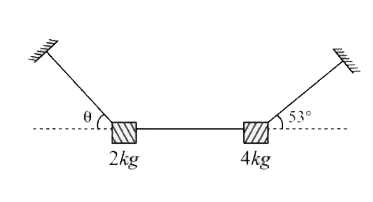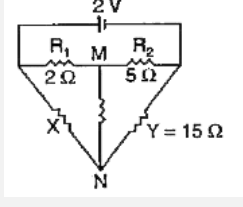The value of ΔH and ΔU will be same for
CaCO3(s)→CaO(s)+CO2(g)
SO2(g)+12O2(g)→SO3(g)
N2(g)+3H2(g)→2NH3(g)
H2(g)+l2(g)→2HI(g)
To determine the reaction for which the values of ΔH (enthalpy change) and ΔU (internal energy change) are the same, we can use the relationship:
ΔH=ΔU+ΔNgRT
where ΔN_g is the change in the number of moles of gas (products - reactants), and R is the universal gas constant, and T is the temperature in Kelvin.
1. Identify the Reactions: We have four reactions to analyze:
- (1) CaCO₃ (s) → CaO (s) + CO₂ (g)
- (2) SO₂ (g) + ½ O₂ (g) → SO₃ (g)
- (3) N₂ (g) + 3 H₂ (g) → 2 NH₃ (g)
- (4) H₂ (g) + I₂ (g) → 2 HI (g)
2. Calculate ΔN_g for Each Reaction:
- Reaction 1:
- Products: 1 mole of CO₂ (g)
- Reactants: 0 moles of gas (only solid)
- ΔN_g = 1 - 0 = 1 (not equal to 0)
- Reaction 2:
- Products: 1 mole of SO₃ (g)
- Reactants: 1 mole of SO₂ (g) + 0.5 mole of O₂ (g) = 1.5 moles of gas
- ΔN_g = 1 - 1.5 = -0.5 (not equal to 0)
- Reaction 3:
- Products: 2 moles of NH₃ (g)
- Reactants: 1 mole of N₂ (g) + 3 moles of H₂ (g) = 4 moles of gas
- ΔN_g = 2 - 4 = -2 (not equal to 0)
- Reaction 4:
- Products: 2 moles of HI (g)
- Reactants: 1 mole of H₂ (g) + 1 mole of I₂ (g) = 2 moles of gas
- ΔN_g = 2 - 2 = 0 (equal to 0)
3. Conclusion:
- For ΔH and ΔU to be equal, ΔN_g must be equal to 0.
- From our calculations, only Reaction 4 satisfies this condition.
Final Answer:
The value of ΔH and ΔU will be the same for the reaction:
H2(g)+I2(g)→2HI(g)
- (1) CaCO₃ (s) → CaO (s) + CO₂ (g)
- (2) SO₂ (g) + ½ O₂ (g) → SO₃ (g)
- (3) N₂ (g) + 3 H₂ (g) → 2 NH₃ (g)
- (4) H₂ (g) + I₂ (g) → 2 HI (g)
- Reaction 1:
- Products: 1 mole of CO₂ (g)
- Reactants: 0 moles of gas (only solid)
- ΔN_g = 1 - 0 = 1 (not equal to 0)
- Reaction 2:
- Products: 1 mole of SO₃ (g)
- Reactants: 1 mole of SO₂ (g) + 0.5 mole of O₂ (g) = 1.5 moles of gas
- ΔN_g = 1 - 1.5 = -0.5 (not equal to 0)
- Reaction 3:
- Products: 2 moles of NH₃ (g)
- Reactants: 1 mole of N₂ (g) + 3 moles of H₂ (g) = 4 moles of gas
- ΔN_g = 2 - 4 = -2 (not equal to 0)
- Reaction 4:
- Products: 2 moles of HI (g)
- Reactants: 1 mole of H₂ (g) + 1 mole of I₂ (g) = 2 moles of gas
- ΔN_g = 2 - 2 = 0 (equal to 0)
- For ΔH and ΔU to be equal, ΔN_g must be equal to 0.
- From our calculations, only Reaction 4 satisfies this condition.
The value of ΔH and ΔU will be the same for the reaction:
H2(g)+I2(g)→2HI(g)
Similar Questions
In which of the following given examples, the value of Vmax changes while the K, value remains same?
View SolutionA : The gravitational force does not depend on the intervening medium .
R : The value of G has same value anywhere in the space
View SolutionTwo van der Waals gases have the same value of b but different values of a. Which of these will occupy greater volume under identical conditions. If the gases have the same value of a but different values of b, which of them will be more compressible?
View SolutionA reaction has both ΔH and ΔS −ve. The rate of reaction
View SolutionThe given system is in equilibrium. The blocks are at same horizontal level. The value of angle is : θ is :

View SolutionThe ratio of the value of any colligative property of KCl solution to that for sugar is nearly 'x' times for water as solvent and same molality. What will be the value of 'x' ?
View Solution"The value of g remains same at all places on the earth surface'. Is this statement true ? Give reason for your answer.
View SolutionIf two sushells have the same value of n + 1, which shell will be filled first?
View SolutionFind the value of resistance X in the given circuit. So that the junctions M and N are the same potential.

View SolutionThe value of current in two series LCR circuits at resonance is same, then
View Solution
